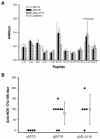Varied immunity generated in mice by DNA vaccines with large and small hepatitis delta antigens
- PMID: 14645554
- PMCID: PMC296071
- DOI: 10.1128/jvi.77.24.12980-12985.2003
Varied immunity generated in mice by DNA vaccines with large and small hepatitis delta antigens
Abstract
Whether the hepatitis delta virus (HDV) DNA vaccine can induce anti-HDV antibodies has been debatable. The role of the isoprenylated motif of hepatitis delta antigens (HDAg) in the generation of immune responses following DNA-based immunization has never been studied. Plasmids p2577L, encoding large HDAg (L-HDAg), p2577S, expressing small HDAg (S-HDAg), and p25L-211S, encoding a mutant form of L-HDAg with a cysteine-to-serine mutation at codon 211, were constructed in this study. Mice were intramuscularly injected with the plasmids. The anti-HDV antibody titers, T-cell proliferation responses, T-helper responses, and HDV-specific, gamma interferon (IFN-gamma)-producing CD8(+) T cells were analyzed. Animals immunized with p2577S showed a strong anti-HDV antibody response. Conversely, only a low titer of anti-HDV antibodies was detected in mice immunized with p2577L. Epitope mapping revealed that the anti-HDV antibodies generated by p2577L vaccination hardly reacted with epitope amino acids 174 to 194, located at the C terminus of S-HDAg. All of the HDAg-encoding plasmids could induce significant T-cell proliferation responses and generate Th1 responses and HDV-specific, IFN-gamma-producing CD8(+) T cells. In conclusion, HDAg-specific antibodies definitely exist following DNA vaccination. The magnitudes of the humoral immune responses generated by L-HDAg- and S-HDAg-encoding DNA vaccines are different. The isoprenylated motif can mask epitope amino acids 174 to 195 of HDAg but does not interfere with cellular immunity following DNA-based immunization. These findings are important for the choice of a candidate HDV DNA vaccine in the future.
Figures







Similar articles
-
Analysis of humoral immunity of hepatitis D virus DNA vaccine generated in mice by using different dosage, gene gun immunization, and in vivo electroporation.J Chin Med Assoc. 2006 Jan;69(1):7-13. doi: 10.1016/s1726-4901(09)70104-2. J Chin Med Assoc. 2006. PMID: 16447920
-
DNA-Based immunization produces Th1 immune responses to hepatitis delta virus in a mouse model.Hepatology. 2000 Jul;32(1):104-10. doi: 10.1053/jhep.2000.8348. Hepatology. 2000. PMID: 10869296
-
Induction of cytotoxic T lymphocyte responses against hepatitis delta virus antigens which protect against tumor formation in mice.Vaccine. 2001 Oct 12;20(1-2):170-80. doi: 10.1016/s0264-410x(01)00252-3. Vaccine. 2001. PMID: 11567762
-
Vaccination against hepatitis delta virus infection: studies in the woodchuck (Marmota monax) model.Intervirology. 2001;44(2-3):154-61. doi: 10.1159/000050042. Intervirology. 2001. PMID: 11509876 Review.
-
Perspectives for a vaccine against hepatitis delta virus.Semin Liver Dis. 2012 Aug;32(3):256-61. doi: 10.1055/s-0032-1323631. Epub 2012 Aug 29. Semin Liver Dis. 2012. PMID: 22932974 Review.
Cited by
-
Protein-peptide arrays for detection of specific anti-hepatitis D virus (HDV) genotype 1, 6, and 8 antibodies among HDV-infected patients by surface plasmon resonance imaging.J Clin Microbiol. 2015 Apr;53(4):1164-71. doi: 10.1128/JCM.03002-14. Epub 2015 Jan 28. J Clin Microbiol. 2015. PMID: 25631795 Free PMC article.
-
Therapeutic Strategies and New Intervention Points in Chronic Hepatitis Delta Virus Infection.Int J Mol Sci. 2015 Aug 18;16(8):19537-52. doi: 10.3390/ijms160819537. Int J Mol Sci. 2015. PMID: 26295228 Free PMC article. Review.
-
Positive selection of hepatitis delta antigen in chronic hepatitis D patients.J Virol. 2007 May;81(9):4438-44. doi: 10.1128/JVI.02847-06. Epub 2007 Feb 14. J Virol. 2007. PMID: 17301143 Free PMC article.
-
Novel prime-boost immune-based therapy inhibiting both hepatitis B and D virus infections.Gut. 2023 Jun;72(6):1186-1195. doi: 10.1136/gutjnl-2022-327216. Epub 2022 Aug 17. Gut. 2023. PMID: 35977815 Free PMC article.
-
Prime/boost immunization with DNA and adenoviral vectors protects from hepatitis D virus (HDV) infection after simultaneous infection with HDV and woodchuck hepatitis virus.J Virol. 2013 Jul;87(13):7708-16. doi: 10.1128/JVI.00645-13. Epub 2013 May 1. J Virol. 2013. PMID: 23637419 Free PMC article.
References
-
- Davey, S. 1996. State of the world's vaccines and immunization, p. 76-82. World Health Organization, Geneva, Switzerland.
-
- Farci, P., A. Mandas, A. Colana, M. E. Lai, V. Desmet, P. Van Eyken, Y. Gibo, L. Caruso, S. Scaccabarozzi, D. Criscuolo, J. C. Ryff, and A. Balestrieri. 1994. Treatment of chronic hepatitis D with interferon alfa-2a. N. Engl. J. Med. 330:88-94. - PubMed
Publication types
MeSH terms
Substances
LinkOut - more resources
Full Text Sources
Other Literature Sources
Research Materials

